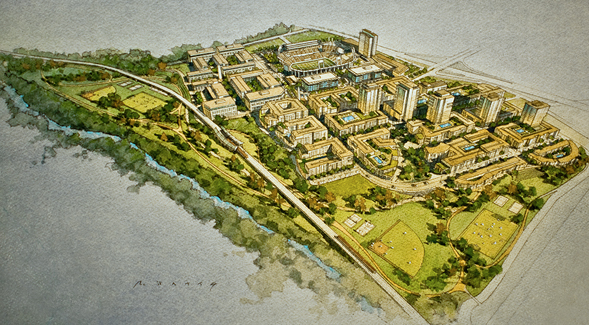SDSU Reveals Detailed Plan for Mission Valley Site
The university plan focuses on economic returns of higher education, open space, and responsible community development.

View the full SDSU Mission Valley site plan and architectural concepts at www.sdsu.edu/missionvalley.“This is a once-in-a-lifetime opportunity to expand the university in a location that is both close to the main campus and large enough to accommodate the university’s growth needs.”
On Nov. 29, San Diego State University unveiled “SDSU Mission Valley,” a detailed vision and plan for the land including and immediately surrounding SDCCU Stadium. The plan features architectural renderings by Carrier Johnson + CULTURE. The university is able to purchase the land at fair market value and finance the construction, should it have the opportunity to do so. The plan does not rely on taxpayer dollars.
SDSU Mission Valley will provide housing for upper-division and graduate-level students, faculty and staff, along with workforce and affordable housing; a new multiuse stadium for collegiate athletics, professional sports, and other entertainment events; commercial office buildings to include innovation and research space; visitor-serving hotels and neighborhood-serving retail uses.
The site plan also features community parks, open space, and recreation fields, accounting for more than 50 percent of the site.
“This is a once-in-a-lifetime opportunity to expand the university in a location that is both close to the main campus and large enough to accommodate the university’s growth needs,” said SDSU President Sally Roush. “It is a plan with the heart and spirit of a modern university campus that will serve higher education and the community’s aspirations for the site.”
“The concept of SDSU Mission Valley is grounded in the guiding principles of creating a true ‘campus feel,’ community engagement, economic return for the region, financing feasibility for the university, and transparency,” added site plan consultant and project manager John Kratzer, CEO of JMI Realty. “Part of our role as experienced private sector developers is helping guide the public-private partnership aspect, which is at the core of the plan.”
The site design, which takes an “open space first” approach, also fully incorporates access to the trolley and other means of public transportation.
“SDSU made it clear to us from the start that a well-executed campus plan on the site must be rooted in environmentally sensitive design that enhances and highlights the San Diego River and creates plentiful open space for the entire community,” said Gordon R. Carrier, FAIA, design principal at Carrier Johnson. “You can see that thoughtful approach reflected in the amenities, from recreation fields to four miles of trails, and a 50-acre community river park.”
Additionally, SDSU plans to mitigate offsite traffic impacts by making meaningful improvements to the local circulation network, as required by the California Environmental Quality Act (CEQA), and in consultation with the City of San Diego and the community planning group.
To effectively serve increasing demands for higher education, and to support the growing regional economic growth, SDSU must identify opportunities for expansion. According to a recent analysis by ICF, an international consulting firm specializing in economic impact studies, the university generates $5.67 billion in economic activity and $457 million in state and local tax revenue each year.
According to Roush, the university is not daunted by the size and scope of the development plan.
“Over the past five years, SDSU has developed more than half a billion dollars in capital projects,” she said. “Whether it is through public-private partnerships, or bonds that would be paid back by revenue generated through the development, we have the resources for the purchase and development of this land.”
Over the coming months, representatives from the university will take their vision for SDSU Mission Valley on the road, presenting to and gathering feedback from community groups, associations, and professional organizations.



